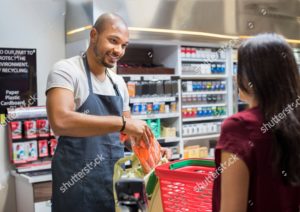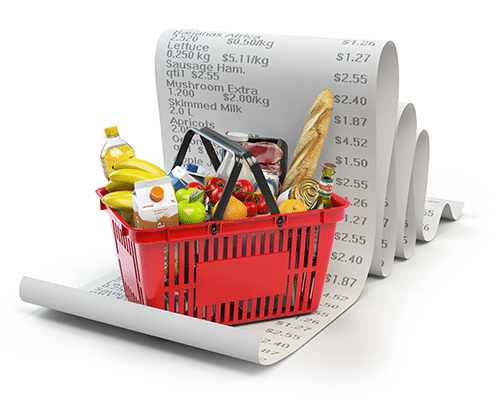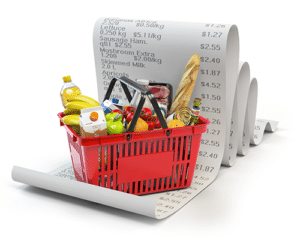With the unprecedented rise in the cost of living, driven by a steep rise in overheads, energy costs and food prices, not to mention increasing competition from online, discounters and multiples, there has never been a more important time for retailers to understand what their customers value and to ensure that day to day actions in-store reflect this.
What shoppers value will differ by store and by customer. For some, price is very important while others value their time more and therefore the convenience or speed of shop is a key factor in choosing a store. The more satisfied shoppers are with perceived value, the more frequently they will visit a store, which in turn will help drive customer loyalty.
So what do customers value?
1. Great Customer Service
Friendly and efficient service with a personal touch can help shoppers feel valued and create a pleasant shopping experience, which for some shoppers can be more important than price.
Store staff play a pivotal role in feeding back shoppers’ views and ensuring that a good level of service is maintained at all times. Store Managers can help by ensuring that there is clear communication to staff on what standards need to be achieved and basic training on how to deliver this. This includes simple things such as a friendly and helpful demeanor, greeting customers, handing shoppers a basket when their hands are full and asking, “Did you find what you were looking for?”
Great customer service can help make your store a destination for shoppers and stems from a good 
Good in-store service can also be supplemented with additional communication. Social Media for example, is a quick and effective way to interact with your customers and advise of any news, promotions or events taking place in-store or linked to your business. Engaging with customers outside of the store is imperative to driving loyalty.
“We have been active on Facebook for a few years now,” comments retailer Mandeep Singh. “We’ve gone from 291 members to over 22,000, increasing our members by over 4,500 during the first national lockdown of 2020. We also use Twitter and have grown those significantly too. It helps us to engage with our customers, build loyalty and through word of mouth, attract new customers. Plus it’s a quick and effective way to share our deals and promotions.”
“We’ve found it to be a great way to connect on a more personal level with our customers,” adds Retail Advisory Panel member Jonathan James.
For more information, see Using Social Media to promote your Business
2. Time Saving and Ease of shop
Time is increasingly being valued as a commodity, so for shoppers with a busy lifestyle, ease and speed of shop can influence store choice. Zoning your store to meet the type of Shopping Mission customers are on (i.e. the reasons they come into the store) makes it easy for them to find what they are looking for, enhances the shopping experience and saves valuable time. Identify the most important shopper mission for your store and make sure that this is in the most prominent area in your store layout. For example, if your store is in a busy urban area, maximise the ‘food-for-now’ mission.
Make sure customers can navigate through your store easily; wide aisles that are clutter free will help shoppers browse the fixtures and move freely. Once shoppers are at the right fixture, help them find what they are looking for through clear signage, POS and utilising category anchors with well-known brands within specific categories e.g. Hellmann’s Mayonnaise, Heinz Tomato Ketchup.
Extra hand baskets should be situated throughout the store so that shoppers do not have to walk back to the front of that store once their hands are full.
As half of all shopping time can be spent queuing to pay, make sure that all staff are till trained to allow extra tills to be opened at busy times. For particularly busy stores, contactless payment and self-scan checkouts can help speed up transaction times. Technology has a key role to play in making shopping even quicker and easier and could even enable some stores to provide a ‘click and collect’ service.
See Shopper Missions, Good Merchandising – Good for Customers, The Importance of Technology in Convenience Stores for more detailed information.
3. Good Ranging and Product Availability
When asked, convenience shoppers consistently state ‘a good range of products’ and ‘product availability’ as being important to them. If customers cannot find what they’re looking for because it is not listed or is out of stock, most will go elsewhere in the future.
Understanding your customers’ shopping habits and the local competition will help you determine a relevant range for your store and could even identify opportunities for a unique range of products that become a footfall driver.
Following planograms from a trusted source such as Partners for Growth will help ensure that the core range of bestselling products have the right space in store to reduce the possibility of ‘out of stocks’.
“We look at each category and adjacencies and the finer details,” comments Ramesh Shingadia. “We use Londis and Partners for Growth planograms – it’s invaluable, impartial advice and the guidelines on merchandising and display on the websites are really good.”
See Get the Ranging Right… Boost Profits for more detailed information
4. Community Involvement
It is not only what you do in-store that counts but also how you engage with your customers outside. For certain store locations playing a key role in the local community can provide some differentiation and drive shopper loyalty. Supporting a local business that acts responsibly and makes a positive contribution to the local area can help shoppers feel part of the local community.
Whether it be sponsoring the local football team, organising local events or even fundraising for local charities, making your store a key part of the community will pay dividends. If you have the space, (either on the shop floor or in additional office space) you could act as a ‘community hub’ for local groups to meet.
“Getting involved in the community takes your customer engagement to the next level. It’s something we can do better than the big supermarkets. People really appreciate you putting something back into the community, they talk to you more and they’re more likely to support you. It also makes the job more enjoyable, as customers like coming in and we like seeing them. And, long term, it shows in profits” comments Mandeep Singh of Singh’s Premier in Sheffield.
See Engaging your local community for more information.
5. Price still has its place!
But price still does have a place in demonstrating value to shoppers, particularly given the dramatic rise in energy, fuel and food prices is causing many shoppers to feel that their weekly food budget is being squeezed, particularly as the cost of energy hits households. What’s more, people are making cuts and saving where possible, in case of recession and job losses, so its important to balance the above elements of great customer service, ease of shop, good ranging and availability and community involvement, with an assurance to your shoppers that your store still offers them great value. This can be achieved through price mark packs on recognisable brands, smaller product sizes for reduced available spend and affordable meal fillers. Source See our article on Delivering Value.
Even though retailers face tough competition, there are many ways to encourage customer visits and encourage spend in-store. Through regular re-assessment of the business, updating of the range and fulfilling customer demands, retailers can ensure that their business remains successful. So why not find out what your customers want through a quick customer survey and see where their feedback takes you?





132 Responses
4ldxse
217zm8
5usl6d
i1cs1z
cltocc
47yq5x
nxyy99
u9zq4p
kqcvp7
1y8xbi
4ulk1t
gvrys5
0dq7oe
l4c96a
8ookmt
9motvq
eplpf2
200d3l
f3cc8b
n9xcpm
722kd1
Hi my loved one! I wish to say that this post is amazing, great written and include almost all vital infos. I¦d like to see more posts like this .
Your text resonates like a familiar melody, awakening subtle memories and insights without force, guiding the reader into a reflective, immersive space where meaning unfolds naturally and gracefully.
bz2ua4
vc37qd
I am constantly thought about this, thankyou for posting.
Fantastic site. Plenty of useful info here. I?¦m sending it to several pals ans additionally sharing in delicious. And naturally, thank you for your effort!
I haven’t checked in here for some time since I thought it was getting boring, but the last few posts are good quality so I guess I will add you back to my daily bloglist. You deserve it my friend 🙂
Hello. fantastic job. I did not expect this. This is a remarkable story. Thanks!
Hello! I could have sworn I’ve been to this blog before but after browsing through some of the post I realized it’s new to me. Anyways, I’m definitely happy I found it and I’ll be book-marking and checking back frequently!
Currently it looks like Expression Engine is the preferred blogging platform out there right now. (from what I’ve read) Is that what you are using on your blog?
My programmer is trying to convince me to move to .net from PHP. I have always disliked the idea because of the costs. But he’s tryiong none the less. I’ve been using Movable-type on several websites for about a year and am nervous about switching to another platform. I have heard good things about blogengine.net. Is there a way I can import all my wordpress posts into it? Any kind of help would be greatly appreciated!
Hmm it appears like your website ate my first comment (it was extremely long) so I guess I’ll just sum it up what I wrote and say, I’m thoroughly enjoying your blog. I as well am an aspiring blog blogger but I’m still new to everything. Do you have any helpful hints for first-time blog writers? I’d certainly appreciate it.
I am always browsing online for articles that can aid me. Thanks!
When I initially commented I clicked the “Notify me when new comments are added” checkbox and now each time a comment is added I get four e-mails with the same comment. Is there any way you can remove me from that service? Thank you!
I am very happy to read this. This is the type of manual that needs to be given and not the accidental misinformation that’s at the other blogs. Appreciate your sharing this greatest doc.
Hi there, just became alert to your blog through Google, and found that it’s really informative. I’m gonna watch out for brussels. I’ll be grateful if you continue this in future. Lots of people will be benefited from your writing. Cheers!
130h8j
Hello, Neat post. There’s an issue together with your site in web explorer, would check this… IE nonetheless is the marketplace chief and a good section of other folks will leave out your fantastic writing due to this problem.
I will right away seize your rss feed as I can’t find your e-mail subscription hyperlink or newsletter service. Do you’ve any? Please allow me realize so that I may just subscribe. Thanks.
I am pleased that I observed this blog, precisely the right information that I was searching for! .
Some really excellent content on this web site, thankyou for contribution.
caimfd
An fascinating dialogue is value comment. I think that you must write extra on this subject, it may not be a taboo topic however typically individuals are not enough to talk on such topics. To the next. Cheers
You made a few good points there. I did a search on the subject and found the majority of people will consent with your blog.
3yxews
What’s Happening i’m new to this, I stumbled upon this I’ve found It absolutely useful and it has helped me out loads. I hope to contribute & aid other users like its helped me. Good job.
Hi would you mind stating which blog platform you’re working with? I’m going to start my own blog in the near future but I’m having a hard time selecting between BlogEngine/Wordpress/B2evolution and Drupal. The reason I ask is because your layout seems different then most blogs and I’m looking for something completely unique. P.S My apologies for being off-topic but I had to ask!
Enjoyed reading through this, very good stuff, thanks. “All of our dreams can come true — if we have the courage to pursue them.” by Walt Disney.
Nice post. I learn something more challenging on different blogs everyday. It will always be stimulating to read content from other writers and practice a little something from their store. I’d prefer to use some with the content on my blog whether you don’t mind. Natually I’ll give you a link on your web blog. Thanks for sharing.
It’s perfect time to make a few plans for the longer term and it’s time to be happy. I’ve learn this submit and if I may just I want to counsel you few fascinating issues or tips. Maybe you could write subsequent articles regarding this article. I desire to learn even more issues approximately it!
Hello, Neat post. There’s an issue together with your web site in web explorer, might check thisK IE nonetheless is the marketplace chief and a big portion of other people will omit your magnificent writing because of this problem.
I was recommended this website by way of my cousin. I’m no longer sure whether this put up is written via him as nobody else understand such certain approximately my trouble. You are wonderful! Thank you!
UK Personal Protection Ltd offers SIA-licensed bodyguards for hire in London, across the UK, or worldwide. Their operatives are highly trained in close protection, anti-ambush, hijack response and first aid, delivering confidential, bespoke security solutions to VIPs, executives, diplomats, and high-risk individuals.
I really like your writing style, excellent information, regards for posting :D. “Every moment of one’s existence one is growing into more or retreating into less.” by Norman Mailer.
Thankyou for this fantastic post, I am glad I noticed this site on yahoo.
I¦ve been exploring for a bit for any high-quality articles or blog posts in this sort of space . Exploring in Yahoo I at last stumbled upon this site. Reading this information So i am satisfied to exhibit that I’ve a very excellent uncanny feeling I discovered exactly what I needed. I most indubitably will make certain to don¦t put out of your mind this website and give it a glance on a relentless basis.
It’s a pity you don’t have a donate button! I’d certainly donate to this outstanding blog! I suppose for now i’ll settle for book-marking and adding your RSS feed to my Google account. I look forward to brand new updates and will talk about this website with my Facebook group. Chat soon!
What does a Farmasi Europa Beauty Influencer account mean? Earn money at your own pace and personally with Farmasi Europa. Five major European countries have joined Farmasi Europa: Spain, Great Britain, France, Italy, Portugal. A bunch of countries that have accumulated tens of thousands of Farmasi Europa beauty influencers.
certainly like your website but you need to check the spelling on quite a few of your posts. A number of them are rife with spelling issues and I find it very troublesome to tell the truth nevertheless I will surely come back again.
Woah! I’m really digging the template/theme of this website. It’s simple, yet effective. A lot of times it’s very difficult to get that “perfect balance” between usability and appearance. I must say that you’ve done a great job with this. In addition, the blog loads extremely fast for me on Firefox. Superb Blog!
Nutriplus Farmasi.com.ro suplimente alimentare și de sănătate unice pe piața din Europa. Ofertă unică pe piața suplimentelor din Europa: Nutriplus cu susținerea sănătății și a frumuseții din interior. Alege farmasi.com.ro pentru produsele Nutriplus România!
I’m still learning from you, while I’m improving myself. I definitely enjoy reading everything that is posted on your site.Keep the information coming. I enjoyed it!
You have observed very interesting details! ps decent internet site.
I have recently started a site, the info you provide on this site has helped me tremendously. Thanks for all of your time & work.
After research a few of the blog posts in your web site now, and I truly like your method of blogging. I bookmarked it to my bookmark website list and will be checking again soon. Pls try my site as well and let me know what you think.
Nice blog here! Also your site loads up fast! What host are you using? Can I get your affiliate link to your host? I wish my web site loaded up as quickly as yours lol
We’re a group of volunteers and opening a new scheme in our community. Your site provided us with valuable info to work on. You’ve done a formidable job and our whole community will be thankful to you.
You are my inspiration, I have few blogs and occasionally run out from brand :). “Follow your inclinations with due regard to the policeman round the corner.” by W. Somerset Maugham.
I am no longer sure the place you’re getting your information, but great topic. I must spend some time finding out much more or understanding more. Thanks for wonderful information I was looking for this info for my mission.
Thanx for the effort, keep up the good work Great work, I am going to start a small Blog Engine course work using your site I hope you enjoy blogging with the popular BlogEngine.net.Thethoughts you express are really awesome. Hope you will right some more posts.
I got good info from your blog
One more issue is that video gaming became one of the all-time biggest forms of fun for people of every age group. Kids engage in video games, and adults do, too. The actual XBox 360 is probably the favorite games systems for those who love to have hundreds of activities available to them, as well as who like to play live with other people all over the world. Thanks for sharing your ideas.
Thanks for the auspicious writeup. It actually used to be a entertainment account it. Glance advanced to more added agreeable from you! By the way, how can we keep up a correspondence?
Thanks for the thoughts you are discussing on this site. Another thing I would really like to say is getting hold of copies of your credit rating in order to check out accuracy of each detail will be the first activity you have to accomplish in credit score improvement. You are looking to clear your credit profile from destructive details flaws that damage your credit score.
What i do not understood is if truth be told how you’re not actually much more smartly-favored than you may be right now. You’re very intelligent. You know therefore considerably in relation to this topic, made me in my opinion imagine it from a lot of numerous angles. Its like men and women are not fascinated except it is something to accomplish with Lady gaga! Your personal stuffs excellent. All the time deal with it up!
Thank you for the sensible critique. Me & my neighbor were just preparing to do some research about this. We got a grab a book from our local library but I think I learned more clear from this post. I am very glad to see such wonderful info being shared freely out there.
Oh my goodness! an amazing article dude. Thank you Nonetheless I’m experiencing difficulty with ur rss . Don?t know why Unable to subscribe to it. Is there anybody getting an identical rss problem? Anybody who is aware of kindly respond. Thnkx
A formidable share, I simply given this onto a colleague who was doing a little bit analysis on this. And he in reality bought me breakfast as a result of I discovered it for him.. smile. So let me reword that: Thnx for the deal with! However yeah Thnkx for spending the time to debate this, I really feel strongly about it and love reading more on this topic. If possible, as you become expertise, would you mind updating your blog with extra details? It’s highly helpful for me. Huge thumb up for this blog put up!
Pretty nice post. I just stumbled upon your weblog and wished to say that I have really enjoyed surfing around your blog posts. In any case I will be subscribing to your rss feed and I hope you write again very soon!
I’m still learning from you, while I’m trying to reach my goals. I definitely love reading everything that is posted on your website.Keep the posts coming. I liked it!
I?¦ve been exploring for a little bit for any high quality articles or weblog posts on this kind of area . Exploring in Yahoo I ultimately stumbled upon this site. Studying this information So i?¦m glad to express that I’ve a very good uncanny feeling I found out just what I needed. I most unquestionably will make certain to don?¦t omit this website and give it a glance regularly.
Thanks for your write-up on the travel industry. I will also like contribute that if your senior taking into account traveling, it truly is absolutely essential that you buy traveling insurance for older persons. When traveling, older persons are at greatest risk of getting a health care emergency. Having the right insurance cover package in your age group can protect your health and provide you with peace of mind.
I have learned some new things as a result of your blog site. One other thing I’d prefer to say is always that newer computer system operating systems often allow more memory to use, but they likewise demand more memory space simply to perform. If a person’s computer is unable to handle much more memory as well as newest application requires that memory increase, it usually is the time to shop for a new Computer. Thanks
It?s in point of fact a great and useful piece of info. I?m glad that you just shared this helpful information with us. Please keep us up to date like this. Thanks for sharing.
Aw, this was a really nice post. In thought I wish to put in writing like this moreover ? taking time and precise effort to make a very good article? however what can I say? I procrastinate alot and by no means seem to get something done.
I have read a few good stuff here. Certainly worth bookmarking for revisiting. I surprise how much effort you put to create such a excellent informative web site.
I switched from another service because of the seamless withdrawals and fast transactions. Charts are accurate and load instantly.
I’ve been active for since launch, mostly for using the mobile app, and it’s always responsive team. Charts are accurate and load instantly.
The using the bridge tools are great support and useful analytics.
Đã bị bóc phốt tùm lum trên các hội nhóm lớn mà vẫn còn đứa nhẹ dạ tin.
Đừng có dại mà nhập thông tin thẻ tín dụng vào, nó rút sạch tiền trong tài khoản đấy.
Mẹ kiếp mất tiền đã đằng này còn bị lấy thông tin đi vay nợ hộ.
Cái web này là một cái bẫy. Vào là chỉ có mất tiền và thông tin.
Tao báo công an rồi đấy, bọn lừa đảo chúng mày cứ chờ đi.
Toàn xúi dại làm chuyện phạm pháp rồi để người ta lãnh hậu quả.
Share link tải phần mềm có dính virus, cài vào là mất hết dữ liệu.
I’m impressed by the quick deposits. I’ll definitely continue using it.
Dịch vụ khách hàng cái đéo gì, lừa được tiền xong là nó block mình luôn.
Tránh xa cái ổ lừa đảo này ra nếu không muốn tan nhà nát cửa.
I have seen loads of useful factors on your web-site about computer systems. However, I have got the thoughts and opinions that netbooks are still not nearly powerful sufficiently to be a good choice if you often do tasks that require lots of power, just like video croping and editing. But for internet surfing, statement processing, and a lot other frequent computer work they are okay, provided you may not mind the screen size. Appreciate sharing your notions.
The learning crypto basics tools are accurate charts and stable performance.
Web này là ổ rửa tiền, dây vào chỉ có đi tù. Né gấp!
Toàn nội dung rác, câu view bẩn thỉu, mục đích là lùa gà.
Nhìn chuyên nghiệp vậy thôi chứ bên trong toàn lừa đảo, dụ dỗ đầu tư vớ vẩn.
Tao báo công an rồi đấy, bọn lừa đảo chúng mày cứ chờ đi.
Click vào quảng cáo của nó là tự động tải về một đống phần mềm gián điệp.
Chúng mày cầm tiền lừa đảo của người khác có ngủ ngon không?
Tránh xa cái ổ lừa đảo này ra nếu không muốn tan nhà nát cửa.
Toàn nội dung rác, câu view bẩn thỉu, mục đích là lùa gà.
Cái web này là một cái bẫy. Vào là chỉ có mất tiền và thông tin.
Cảnh báo lừa đảo! Bọn này đã bị bóc phốt trên mấy diễn đàn lớn rồi.
WONDERFUL Post.thanks for share..extra wait .. ?
Mẹ kiếp, mất tiền thì bực một, bị nó lấy thông tin đi vay app mới cay.
Địt mẹ nó, tao vừa bị hack mất cái nick Facebook sau khi đăng ký ở đây.
Bọn này chuyên thu thập thông tin cá nhân rồi đem bán cho tụi đa cấp.
Cái web này là một cái bẫy. Vào là chỉ có mất tiền và thông tin.
Bọn này chuyên thu thập thông tin cá nhân rồi đem bán cho tụi đa cấp.
Địt mẹ nó, tao vừa bị hack mất cái nick Facebook sau khi đăng ký ở đây.
Bọn này chuyên thu thập thông tin cá nhân rồi đem bán cho tụi đa cấp.
Cái web này là một cái bẫy. Vào là chỉ có mất tiền và thông tin.
Thank you a bunch for sharing this with all of us you actually recognise what you are talking about! Bookmarked. Kindly additionally visit my site =). We could have a link alternate contract among us!
Hello, I think your website might be having browser compatibility issues. When I look at your blog site in Safari, it looks fine but when opening in Internet Explorer, it has some overlapping. I just wanted to give you a quick heads up! Other then that, amazing blog!
Wow, fantastic weblog format! How lengthy have you ever been blogging for? you made blogging glance easy. The full look of your site is wonderful, let alone the content!
The interface is intuitive UI, and I enjoy using the API here. The updates are frequent and clear.
I’ve been using it for half a year for using the mobile app, and the scalable features stands out.
I personally find that i’ve been using it for recently for portfolio tracking, and the clear transparency stands out.
My partner and I absolutely love your blog and find most of your post’s to be precisely what I’m looking for. Would you offer guest writers to write content to suit your needs? I wouldn’t mind creating a post or elaborating on a lot of the subjects you write about here. Again, awesome blog!
F*ckin? awesome things here. I am very satisfied to peer your post. Thank you so much and i am taking a look ahead to contact you. Will you please drop me a e-mail?
I’ve been using it for a month for trading, and the accurate charts stands out.
I was skeptical, but after several months of using the mobile app, the easy onboarding convinced me.
I’ve been absent for some time, but now I remember why I used to love this web site. Thank you, I will try and check back more often. How frequently you update your web site?